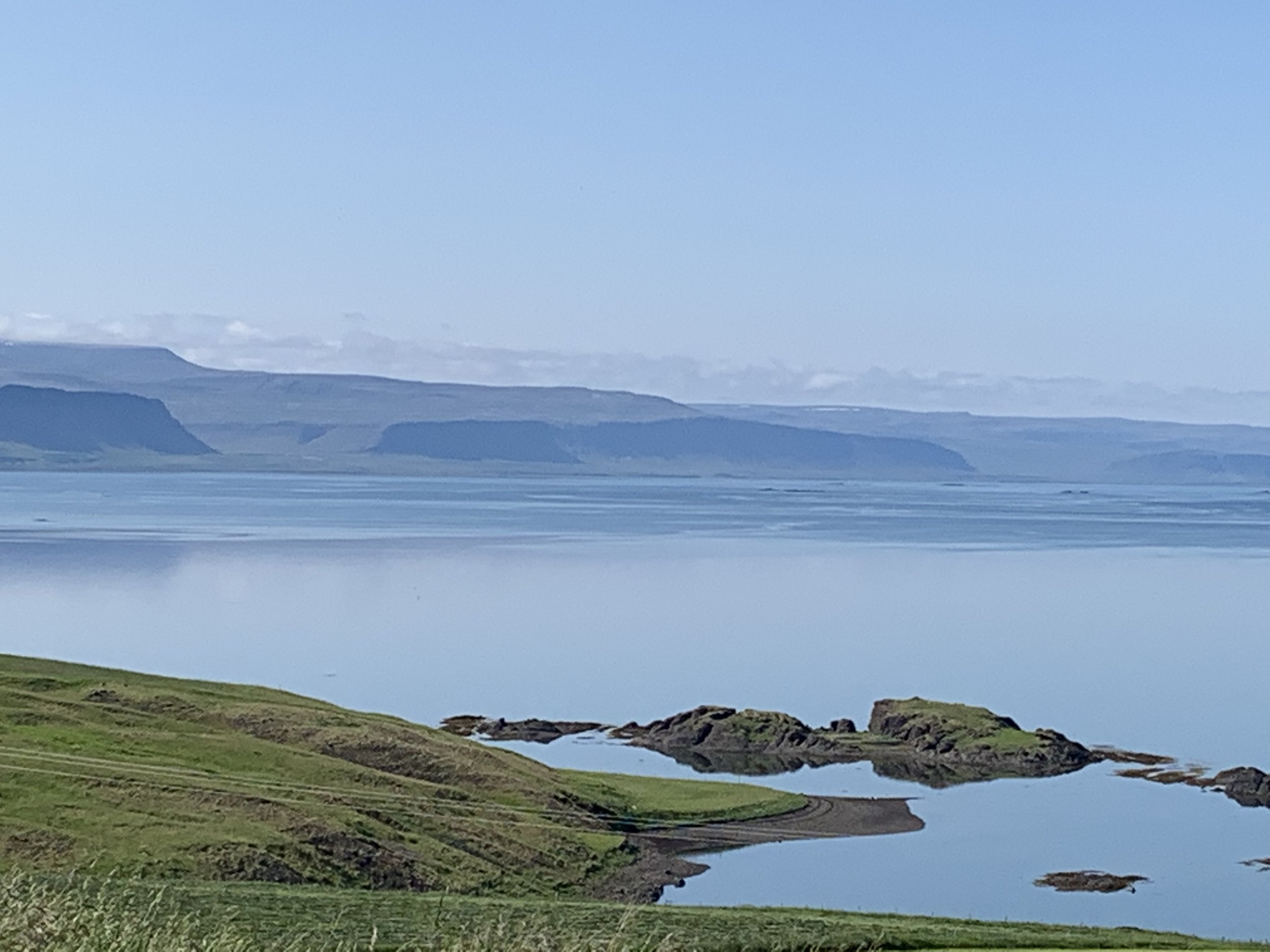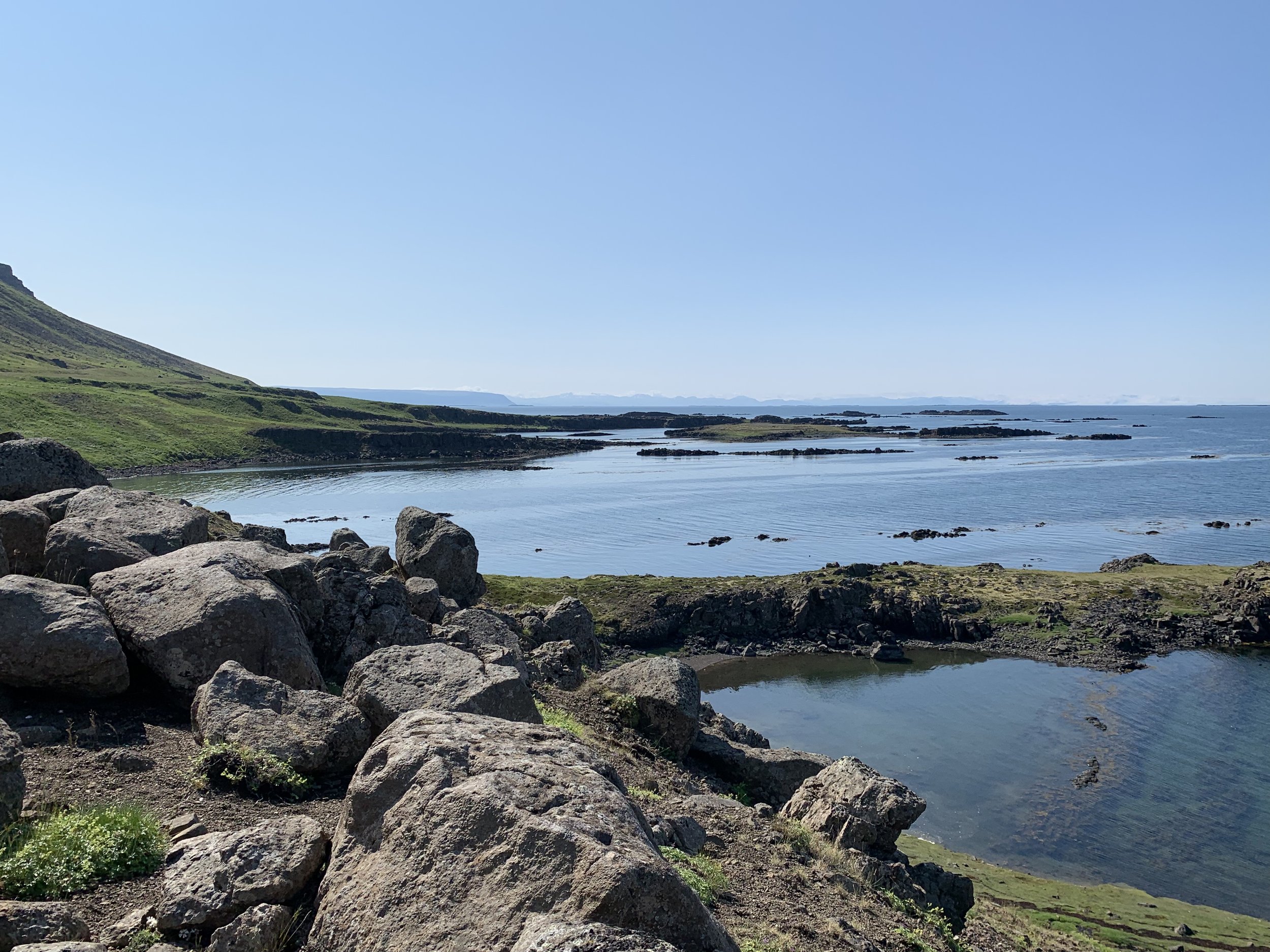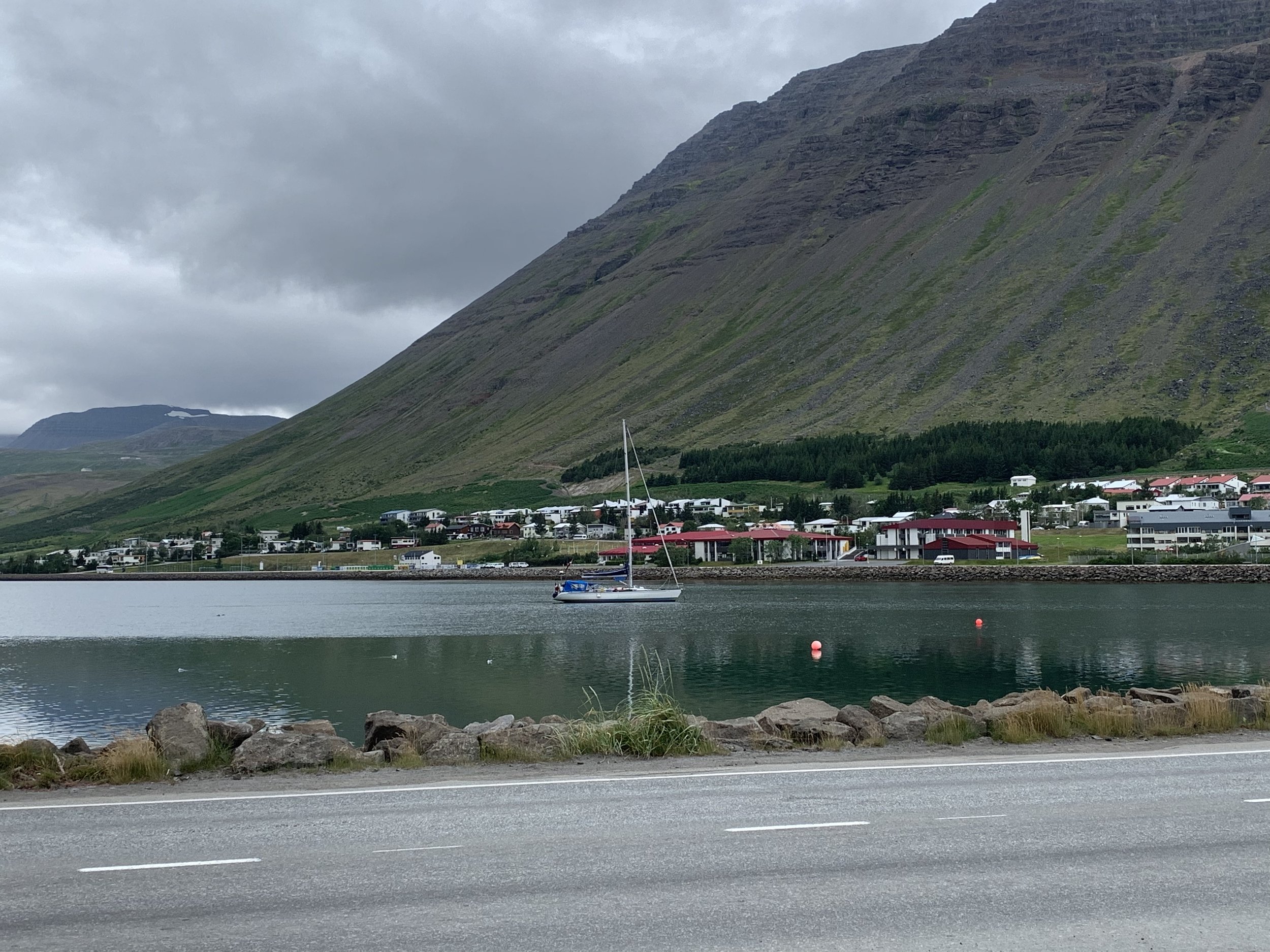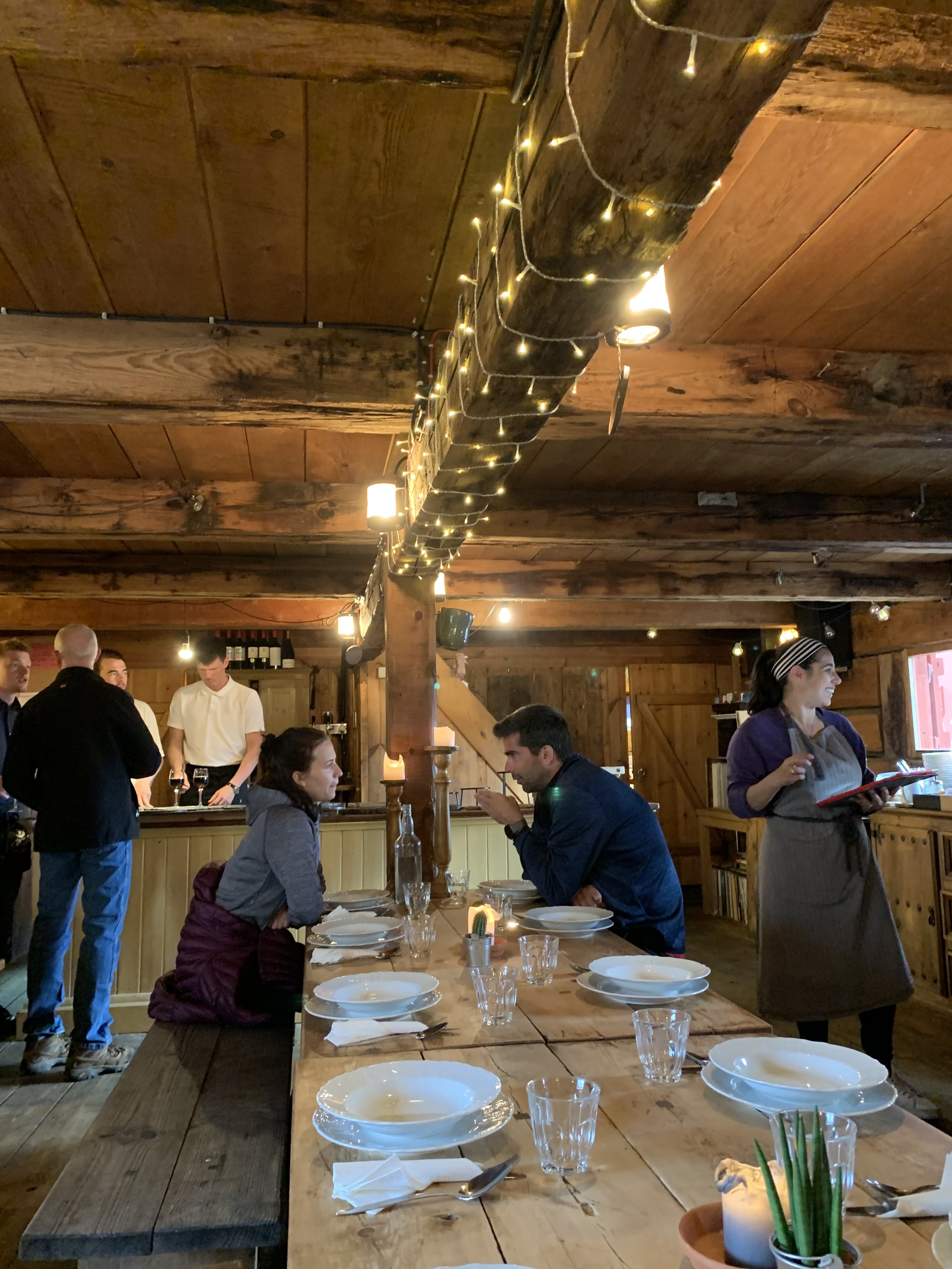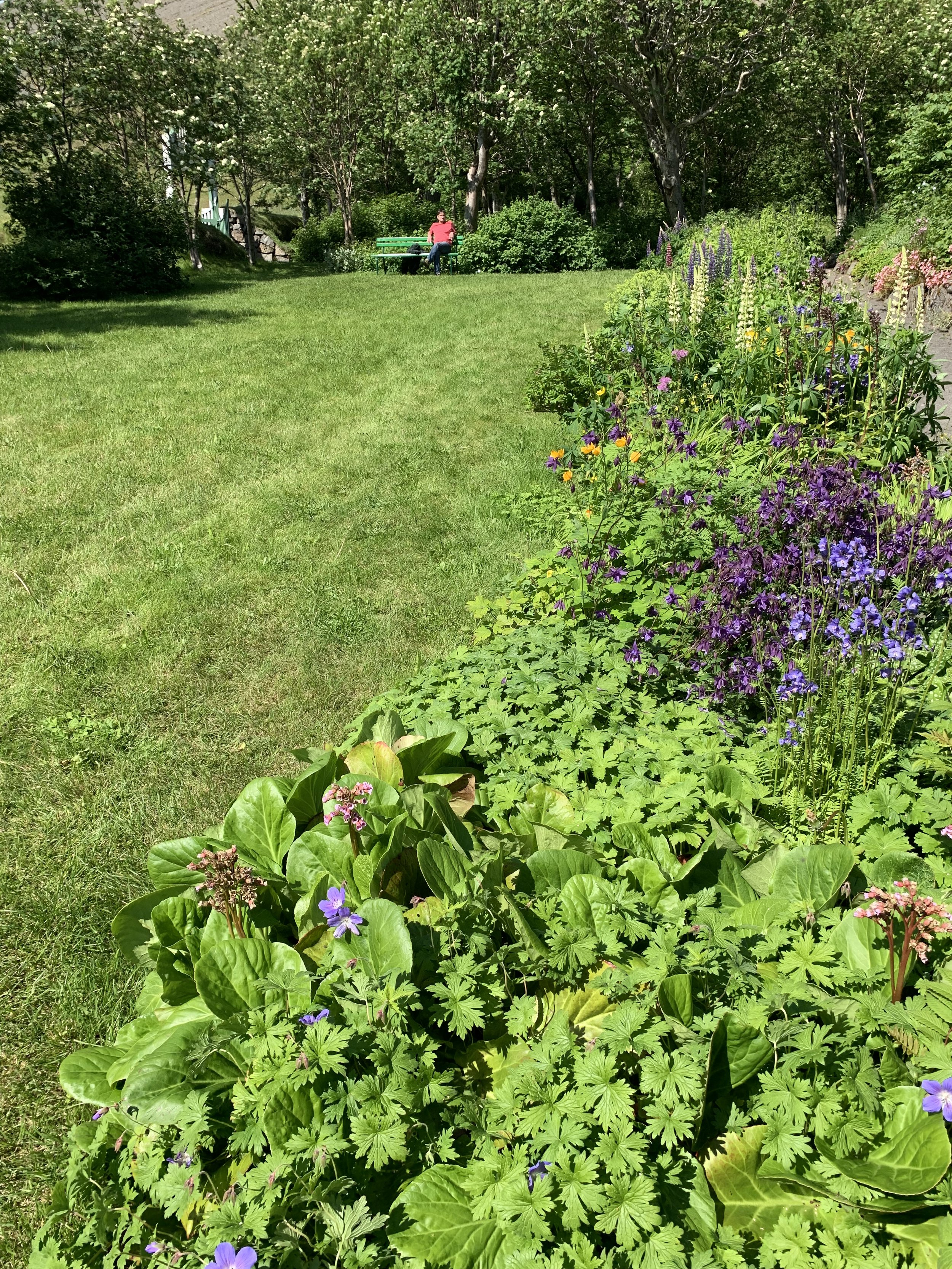The Westfjords of Iceland
The stunning blues and greens of the Westfjords
The Westfjords of Iceland are stunningly beautiful, and an area that a lot of tourists never get to as it’s off the main ring road and involves a lot of driving. Perhaps because of itsrelative remoteness, this region has a very distinct feel to it and it differs from the rest of Iceland both historically and geologically. Apparently, the Westfjords are the oldest part of Iceland, being some 16 million years old!
Being one of Iceland’s most remote and untouched regions, the Westfjords are often known as “Iceland’s Best Kept Secret”. The area is very rural and it takes quite some time to explore, mainly because there are few roads and many of them follow the outline of the fjords. The Westfjords covers an area of approximately 22,000 square kilometres, yet only has a population of around 10,000. This is mainly due to the mountainous and jagged coastline, making travel difficult and time-consuming. The terrain, with its lack of flat land also limits the potential for agriculture, making fishing the primary industry here, and this means that the Westfjords are never likely to be heavily populated.
A misty, late-afternoon view of the fjords
Given how far the Westfjords are from the many popular tourist destinations such as the Golden Circle, Glacier Lagoon, Lake Mývatn, and also from both Reykjavík and Akureyri, it is no surprise that it is so much less travelled than most other areas of the country, and a trip here will almost certainly necessitate allowing a few days, with overnight stays, so it isn’t a cheap option. However, it is well worth taking the time to do as I think it is one of Iceland’s most spectacular and awe-inspiring regions.
Each fjord has very much its own feel and character
The villages are small and few, and most of the journey will be through untouched landscapes and stunningly beautiful scenery that makes the drive an absolute joy. Just as well really, as no matter where in the Westfjords your destination is, there will be many hours of driving! Because the road follows the jagged ins and outs of the coastline it can take a very long time to get from one place to another; as the crow flies, it may not be very far, but because you need to drive right around the edges of the fjords you can end up driving for hours and we underestimated several legs of our journey because we hadn’t appreciated just how long it can take to get from A to B. Although in our case, I think the time it took us to get anywhere was at least partly due to the fact that every few minutes we were trying to find a safe place to stop the car and drink in the stunning views or take photographs of yet another fjord as it revealed itself. Although there are many, many fjords, they can be very different from one another in character and feel. On a sunny day, there can be few places that offer such beauty and variety and as we drove up and down and in and out along the southern coast of the Westfjords we were constantly surprised and delighted by the unfolding scenery as we rounded each bend, or drove over the top of each mountain slope revealing the landscape beyond.
One of the places I mentally walked the footprint of my planned summer home!
One thing that must be noted, if planning a trip here, is that the Westfjords are really only accessible in the summer months, from May to October; snowfall is heavy in the region, and due to the small population, the roads are not as regularly maintained as in the rest of the country. Some of them are little more than gravel tracks and as soon as the weather is bad, the roads are closed as they become dangerous.
There is so much to see and do in the Westfjords that we only really scratched the surface, and we want to go back and explore the area further, but these are a few of the lovely places we visited on this trip:
Rauðasandur
Rauðasandur is quite an unusual beach for Iceland. Most of the nation’s beaches are black, consisting of volcanic sand from the island’s regular eruptions. Rauðasandur, however, is vividly coloured with reddish golden sands, making it an incredibly picturesque location on a sunny day when the sand seems to glow with vivid colour – hence the name which means red beach.
The red sands of Rauðasandur Beach
Rauðasandur is located beneath the Látrabjarg birdwatching cliffs, so it was an obvious place for us to stop and take a break after hours of navigating the fjords on our way to Látrabjarg on the western coast. To walk all along the beach requires wading across a shallow stream, so good footwear (or bare feet) is a must.
Rauðasandur is a good ten-kilometre stretch of beach, surrounded by mountains on three sides and the sea to the other side. It is quite remote and to reach it you have to drive up and down a steep gravel road with incredibly tight hairpin turns. The views are stunning, but it did get to the point where I couldn’t actually look at them as it was just too scary! Definitely one of the most hair-raising roads I’ve experienced in Iceland.
Once we got to the bottom we went for a walk along the beach, enjoying the peace and quiet – unfortunately it wasn’t particularly sunny when we were there so we didn’t see the colours of the beach and the sea at their best, but it is still a lovely walk, with a small campsite near the car park offering basic provisions and tea or coffee.
Apparently, in July the beach, and the campsite, comes alive with the Rauðasandur Music Festival which runs over a weekend in the light of the midnight sun. This large and popular cultural event showcases diverse Icelandic talent, and the proceeds go towards protecting and developing the area.
Látrabjarg
The cliffs of Látrabjarg are on the very southwest side of the Westfjords and in fact this is the westernmost point of Iceland. They stretch for 14 kilometres and are over four hundred metres high in many places, so they are well worth a visit in their own right, simply to wander along the path near the edge of these vertical cliffs and to wonder at the sheer size and scale of them. However, the real draw for me was the fact that Látrabjarg is Iceland's largest bird cliff and home to over a million seabirds, including puffins, guillemots, and the largest razorbill colony in the world. The bird cliff is a breeding area for up to half of some of the species world populations and is therefore listed as an internationally important bird area and a nature reserve.
The sheer scale of these cliffs is quite terrifying
In the summer, these cliffs fill with literally millions of birds, nesting and raising their chicks.
Forty percent of the world’s razorbills nest here, as do many guillemots, fulmars, auks and northern gannets. What most visitors (including me) come looking for and discover in abundance, however, are the puffins.
Although there are many places in Iceland where you can take part in puffin-watching tours, including from Reykjavík’s Old Harbour itself, the remoteness of Látrabjarg and the seclusion and safety for the birds that nest there, means that you can get to within an arm’s reach of these adorable little birds. Because the wind can be incredibly strong along the cliffs you are recommended to lie on your belly and slide along if you want to see the puffins below, as it can be dangerous to stand too close to the edge. This is not just because of the height of the cliffs and the force of the wind, but because puffins dig their burrows into the cliffs themselves, which can cause the earth the be unstable above, making the cliff edge vulnerable to collapse if you should step onto the wrong point!
It’s easy to see why we are encouraged not to stand at the edge of the cliffs…
To read more about our encounter with these charming and funny birds at Látrabjarg, check out my blog post Up close and personal with puffins.
Dynjandi Waterfall
Dynjandi waterfall is so spectacular and awe-inspiring, that it may well be my favourite waterfall so far of those I have seen in Iceland. Having said that, it is actually a series of waterfalls that feed into one another, rather than one single waterfall. They are all named and there are seven separate waterfalls in all. The total height of the accumulated falls is 100 metres, so it really is incredibly impressive, and the series of falls cascade from the top of the fjord all the way down to the bottom. For more information about Dynjandi click this link.
Dynjandi waterfall
Once you park in the car park, there is a path with steps, some man-made, some naturally formed by the rocks and stones in the hillside that follow the falls up to the top one – which is the most impressive and dramatic of all. It’s an amazing walk and we found ourselves stopping again and again at each new cascade of water, to take photographs, both of the water itself and, turning round, of the increasingly stunning view of the fjord which opened out the higher we got.
Turning your back on the waterfall rewards you with this stunning view
I know there are bigger waterfalls in Iceland, higher waterfalls, and more powerful waterfalls, but I really do think that Dynjandi is one of the most spectacular of the falls that I have seen so far. Photographs do not do it justice or capture the sheer scale of it, and I found myself wishing I had a drone as I think that’s probably the only way to show it at its best.
Even on a dull and rather cloudy day we were mesmerised by the scale and beauty of Dunjandi, particularly the topmost waterfall which splays out as it cascades down the rocky mountainside so that it resembles a bridal veil of frothy white. Just gorgeous.
One word of warning; to get to Dynjandi from the south you have to navigate one of the worst roads I have yet encountered in Iceland! This gravel F road forms a treacherous mountain pass that is full of potholes with no rails to protect you from the steep drop so a 4×4 vehicle is necessary to cross the centre of the Westfjords. This road is closed during the winter as it is just too dangerous to even attempt.
Ísafjörður
Known as the ‘Capital of the Westfjords’, Ísafjörður is the largest town in the region. Having said that, it only has a population of 2,600 (which gives you a good indication of how scarcely populated the rest of the region is). To get to Ísafjörður you can either drive over the mountains on gravel roads, or through really long tunnels (we arrived by the former route and left by the latter). Ísafjörður is definitely the centre of culture for the region and has more places to stay as well as more bars, restaurants and shops than anywhere else in the Westfjords. It also boasts some of the oldest buildings in Iceland, dating back to the 18th century.
Ísafjörður harbour
One of these buildings houses what has to be the best fish restaurant I have ever eaten in. Called Tjöruhúsið, it is situated down by the harbour and housed in an incredibly old wooden barn-style building – apparently, it used to be a tar factory and is dated from 1781. Inside, it is reminiscent of a medieval tavern, with low timber beams and tables flanking the walls, and it is apparently pretty famous. We met a couple who had tried to come and eat there only to find it was fully booked for weeks ahead, and they had been so keen to come that they planned a second visit to Ísafjörður some two or three weeks later at the end of their Westfjords trip, just to get a meal there! At the time we didn’t know how busy it was, so just wandered in at around 10am and got chatting to them and asked if they had availability for that evening. I did wonder why we were met with laughter when we asked, but we were incredibly lucky and they told us that if we turned up around 8.30pm they would squeeze us in.
They were good to their word, and that evening we turned up for our booking to find that the place was full to bursting with people queuing outside, but we were given seats at one of the long refectory style wooden tables, with benches either side. This is not a place where you get a quiet table for two, but instead, everyone squeezes in along the long tables, and you find yourself chatting to strangers and exchanging experiences and stories
The evening meal is an all you can eat seafood buffet, and the waiters let each table know when it's their turn to go up and get their food. We started with a seafood soup which was incredibly good, and then went up to pick out what we wanted from the different pans on display. The menu consists of that day’s catch and so will change from day to day. We had a variety of different fish, from one of the local specialities gellur or cod cheeks, dusted in flour and pan fried, to wolffish in a creamy sauce with grapes, and halibut, pan fried haddock, salted cod and probably more but I rather lost track of what I tried, there was such an eye-catching and mouthwatering variety. I know it all tasted very good though. With a selection of side dishes; fresh new potatoes, vegetables and salads, there was so much food that it would take more than one visit to try everything. I have tried many seafood restaurants, both before and since visiting Tjöruhúsið but I can’t remember a meal that stood out in quite the way that this did! Absolutely incredible food and a wonderful evening.
Þingeyri
Þingeyri village in Dyrafjordur fjord is located 50 km from Ísafjordur. Dyrafjordur is very beautiful and is often said to be the most beautiful fjord in the whole of Westfjords. It is surrounded by mountains that rise majestically around the little village and are often referred as the “Westfjord´s Alps”. We were lucky enough to be staying a little way out of the village itself in a valley within these ‘Alps’ with a view of Kaldbakur, which is the highest mountain in the Westfjords, in a picture perfect little chalet cabin which it turned out was off the grid (although even tucked away and off the grid we still were able to get intermittent wifi so we were not totally cut off).
Our little off-grid cottage with its own woodland area
This was my favourite accommodation of the entire trip, nestled into a little woodland copse in the shallow valley bowl of the surrounding mountains, surrounded by beautiful scenery and home to all sorts of birds that we had never seen before. The evenings were particularly cosy, lit only by the many candles and lanterns in the cabin - sadly it wasn’t cold enough to make use of the log burner which would have notched the cosiness factor up even further!
Views of the inside and outside of our little cottage, and the view from our balcony
A short drive from our cabin, Þingeyri itself is a sleepy little village but very pretty and only takes a few minutes to explore by car. We did discover Simbahöllin, which was a pretty and cosy café that had been recommended to us and which is famous for its Belgian waffles – which it seemed rude not to try! They were home-made and very delicious indeed. Definitely worth a visit. After the indulgence of waffles, we drove along the shore of the fjord looking out for the seals who often visit, and we were lucky enough to see several of them basking in the shallow water in the intermittent sunshine. We also passed a beach where there were a whole load of sheep, randomly wandering about on the sand and in the shallows - do sheep go on holiday??
Skrúður Botanical Garden
On the other side of the Dýrafjörður fjord from Þingeyri, nestled into the mountainside is Skrúður garden. We had read that there was a botanical garden near Þingeyri and, for a country really not noted for its gardening, I was fascinated to find it and see what it was like. Perhaps I was misled by the term Botanical Garden, as I think I had been imagining something like a smaller version of Wisley or Kew… Well, it’s definitely smaller!!! But absolutely delightful.
Our first view of the garden entrance and low wall set against a magnificent mountain backdrop
Skrúður is a tiny little botanical garden surrounded by a low stone wall. It sits in the lee of a mountain, set back a short way from the banks of the fjord and is pretty much in the middle of nowhere! Surrounded by the rather harsh yet majestic landscape, you enter this little garden and are immediately transported to a different world. With small paths, tiny lawns, colourful flowerbeds and fruit trees, this is like a little English country garden, in the middle of the Icelandic landscape. With a tiny greenhouse in the centre, it is a peaceful and secluded gem of a garden.
Skrúður was founded in 1909 by Sigtryggur Guðlaugsson, a Protestant pastor and teacher at the nearby boarding school of Núpur. The purpose of the garden was to educate the school’s students, teach them how to work the land, to take care of plants, and be able to recognize them. Guðlaugsson and his students slowly erected an enclosure, removed the stones, dug the ground, and planted the trees that still flourish today.
It was an incredible undertaking and has resulted in a place that is truly unique. The contrast between the cultivated space with its delicate flowers and shaded seats and the harsh, almost barren landscape that it sits in is breathtaking. It also has one of the most amazing ‘garden gates’ I have ever come across, created as it is from the jawbones from a fin whale caught in 2010, creating an archway at the end of the garden. The original gate was made from the jawbones of a blue whale caught in 1892 but these have now been moved to the Natural History Museum in Bolungarvík.
The gateway created from the huge jawbones of a fin whale
Bolafjall mountain
A short drive to the north west of Ísafjörður is Bolungarvík, which is the very northernmost village in the Westfjords, situated on a cove of the same name. The fishing village itself is small (although with a population of only 950 it is actually the second largest town in the Westfjords!) but picturesque, surrounded by coastal mountains and absolutely stunning scenery in all directions.
Some of the views from Bolafjall mountain and the radar station
Just out of Bolungarvík, a few minutes inland, it is possible to turn right and drive up to the top of Bolafjall mountain. The drive is another of those heart-in-your-mouth rides, as you twist and turn, zig-zagging up the steep mountainside… not so bad for the driver, but for the passenger who is on the outside of the road it is terrifying seeing the road drop away and a huge expanse of nothingness that gets worse the higher you climb. Bolafjall is some 638m high (around 2,100 feet) and on the top of the mountain there is a former US radar station which is now operated by the Icelandic Coastguard. Many people climb this mountain on foot – I found it terrifying enough in the car, so there is no way I’d attempt to climb it, but it is a very popular climb for those who like such things. Extreme caution is advised as the slopes are steep and dangerous, but the staggering view that is offered from the summit make the climb worthwhile. It really is breathtaking. They say that on a clear day you can even see Greenland (but I don’t think we did).
Stunning - if somewhat vertiginous viewpoint
Skálavík beach
When we came back down from Bolafjall, we continued down the road from Bolungarvík to Skálavík Beach, where we had lunch. This is so picturesque and pretty, with a few summer homes scattered about near the beach itself. This is one place I would love to own a summer home! We sat at a rough and ready table made from a cable reel to have our lunch in the sunshine enjoying the views in every direction, after which we wandered along the beach, keeping a safe distance from where the arctic terns were nesting.
Looking back from the beach towards the valley from our makeshift lunch table
Not all visitors were as aware of the tern nesting sites though and discovered that they were too close the hard way, as they were attacked and dive-bombed by the protective parents! Arctic terns can be very aggressive if you go too close to their nests and it was very funny watching people trying to protect themselves with their bags, walking poles or even cameras as these feisty little birds swooped and squawked at them, diving directly for their heads and faces.
Skálavík Beach
The area is uninhabited except for the few summer homes, with no facilities beyond some timber-built loos, and a few tables and chairs, but I loved it. Both the bay itself and the grassy valley floor, with gurgling streams and grassy banks are very pretty indeed. It felt very special and it’s one of the places I would love to go back to and revisit.
Hólmavík
Driving back down through the Westfjords from Ísafjörður we stopped for a coffee break in Hólmavík, a small fishing town nestled by the large Steingrímsfjördur fjord. It is the largest town in the dramatic and largely uninhabited Strandir region and the perfect place to take a break on the journey back towards the ring road in the main part of Iceland. There is very little there, other than a few houses, a couple of coffee shops and a pretty church with rainbow steps, but it was a good place to stop for a while.
The pretty Hólmavík church
We had a fabulous drive back along the west side of the Hrútafjörður fjord, stopping to have a picnic lunch on the beach on the way – only to realise we were looking across the bay to the little Airbnb cabin that we had stayed in on the first night! How bizarre, to make a random stop for a picnic and to find we were looking at a familiar view, but from the other side!
There is so so much more to see in the Westfjords and we definitely intend to go back, but I do feel very lucky to have experienced a taster of this amazing part of Iceland that very few people ever get to see.
Sun setting over the Westfjords
